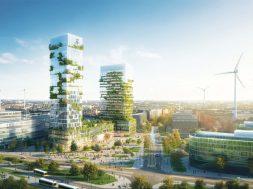Can India lead on green building?
A comprehensive analysis on India’s progress towards sustainable development.
India is amongst one of the few nations’ leading the green building movement. The green building movement started in India 15 years back and has had a tremendous growth by achieving over 3 billion sq. ft. of green footprint. Presently, India ranks third on the US Green Building Council’s (USGBC) annual ranking of top 10 countries for Leadership in Energy & Environmental Design (LEED) certified buildings. India has a concrete set up for authorisation, certification and promotion of green buildings. The Indian Green Building Council (IGBC), formed by CII is an authority licensed by LEED. Furthermore, the presence of USGBC, IGBC and TERI, the leading green building rating councils have continued to contribute to the success of greening in India.
There is a clear demand for green and sustainable buildings in the current construction scenario. On this note, M. Guruprasad Pandit, Senior Manager, LEAD Consultancy & Engineering Services (India) says, “The green movement is exponentially transmuting the built environment into healthy, energy efficient buildings and benefiting planet and the people. India shall surely surpass and become a leading light for developing nations in the near future for embarking a pioneer role in green building industry.”
JR Tanti, Director, Synefra Infrastructures Pvt. Ltd. and Co-Chairman, IGBC Pune Chapter, opines, “Green building movement in India is at its peak at this point of time and we can only see it growing from here. Now there is no coming back because the benefits and gains are obvious to all stakeholders – government, policy makers, developers, investors and most importantly the users.”
Rumi Engineer, Sr. General Manager and Business Head – Green Building Consultancy Services at Godrej and Boyce comments, “Green concepts lower the building’s energy, water and operating costs. Therefore, the green building movement has shifted from ‘push’ to ‘pull’ with markets increasingly demanding no less than green buildings.”
In the next 15 years, Indian buildings are expected to reach 100 billion sq. ft. of area. India has over 2,000 green building projects and over 60 LEED platinum constructions. Ramdas Shenoy, Director Marketing, GIBSS, states, “The buildings, implementing greener options, more on the demand side of energy requirements will help in making the building more greener and energy efficient.“
India’s lead on green buildings
The IGBC has set an ambitious target of achieving 10 billion sq. ft. of green building base in the country by 2022. Looking at the current scenario, it is evident that smart, sustainable green buildings have become a necessity in today’s life to protect our environment. “The green buildings sector is growing at a steady pace and not to be surprised if it surpasses its competitors Canada and China soon,” predicts Mr Pandit.
Speaking on India’s lead on green building, Dr Anil Jindal, Chairman, SRS Group, says, India has the potential to lead as a global leader in green building space. He says, “The recent steps of the government in housing and realty sector such as affordable housing and smart cities, if carried out carefully in tandem with the green building wave, can certainly take the country to the zenith. The current growth of the country supports the trend and it will be set higher.”
Building green buildings as India expands, is one example of the leapfrogging potential that all developing economies can benefit from. Mr Engineer, suggests, “Rather than using 20th century building practices and then retrofitting for efficiency down the line, building green from the start could enable companies and the country to make more rapid progress towards their sustainability goals.”
Commenting on India’s lead on green buildings, Reshu Singh, Director Projects Portfolio, TRANSVEN says, “70 per cent of India’s building stock in 2030 is yet to be built, where green buildings would play an important role.”
Challenges
Lack of skilled workforce who understands green building concept is a major concern in India. Speaking on the challenges, Mr Pandit, says, “There exists a concern to link the gap of technological understanding of green buildings to incorporate socioeconomic aspects. The biggest challenge for India is the gap between the technology and economic position”
The key challenges in the sector are lack of stakeholder awareness and paucity of competent consultants.
According to Dr Jindal, “Stakeholders are reluctant to adopt the practice of awareness mostly due to lack of awareness on benefits of green buildings, materials and technology.”
Many builders and developers still don’t see the value in building green or when they do, they still treat sustainability as an add-on feature. Mr Engineer says that half-baked information does more damage than ignorance. He says, “The challenge is to understand the whole gamut of green process, correlate the same with project design and have constant focus on the cost-benefit analysis.”
Whereas Mr Shenoy, says, “Challenge lies in implementation of green building codes. It is still more a voluntary option rather than compulsion in most of the states. Once it is mandatory across the board, then we will see faster adoption of green building practises.”
Ms Singh believes that green buildings are costly. However, Mr Tanti points out, “myths about green building being a costlier option” is a major concern.
Addressing the challenges
Green building sector is facing many challenges at the moment, however experts believe, to do away with the challenges it is necessary to increase the awareness among public about the benefits of green projects and the resultant gains to the buyers will be imperative. “Government should facilitate green funds to involve industries in the process of providing green materials and to facilitate green movement in real estate development,” Dr Jindal suggests. “Collaboration between private sector and the government will bring better results. Legislation too can be of much use. New codes like mandatory energy, water usage audits and other such rules should be made mandatory.” According to Mr Pandit the amalgamation of various building sector professions at inception stage of the project is required to ensure they are part of entire system process that is concept to completion and beyond.
Incentives for builders
The development of green buildings in India has witnessed significant growth. Environment Ministry gives green buildings priority in the environmental impact assessment process. In addition, the alternative rating system in India called GRIHA (Green Rating for Integrated Habitat Assessment) has also seen a considerable increase in the registration of green buildings. To name a few, local city development and administration authorities like Delhi Urban Art Commission (DUAC), Surat Municipal Corporation (SMC) and Surat Urban Development Authority (SUDA), Pimpri, Chinchwad Municipal Corporation (PCMC) have incentivised green initiatives to enhance the growth of green buildings not only in large cities, but also in smaller municipalities around India. This clearly shows that growth of green buildings in India is not only being supported by end-users and developers but also by the government and local city administration authorities.
Tax and premium rebates are primary in the Indian landscape. Apart from central levels, incentives are offered at state level and city authority levels. The GRIHA platform has been substantial to offer the required assistance to incentivise the sector. Property tax based incentives are being adopted by a number of authorities throughout the major metropolitans as well as Tier I and Tier II cities. Another widely adopted form of rebates offered by municipalities is on Floor Space Index (FSI) or Floor Area Ratio (FAR), the built-up floor area of a building relative to the size of the plot it is built on. On this note, Dr Jindal, says, “Many municipalities incentivise developers to build green, by allotting a portion of this extra FSI of efficient buildings for no cost. This increases the value of the real estate properties.”
On explaining the incentives builders get while developing green buildings, Mr Engineer, states, “Certified green buildings in Mumbai could soon get up to 20 per cent discount on property tax as per a proposal being considered by the municipal corporation to incentivise environment-friendly buildings.”
Mr Shenoy says, “To incentivise developers to build green, a portion of extra FSI is given to developers of efficient buildings for no cost, increasing the value of their properties. The Noida region outside Delhi allows GRIHA-certified gold or platinum rated buildings that have plots exceeding 3,000 sq. m. to exceed the FSI limit by 1 to 5 per cent.”
“Additional FAR is provided to builders and developers applying for green building certification by development authorities like NCR, Punjab, Faridabad, and Kolkata,” informed Ms Singh.
According to Mr Tanti, the Ministry of Environment & Forests (MoEF), Government of India offers fast track environmental clearance for projects following IGBC guidelines and which are pre-certified. Small Industries Development Bank of India (SIDBI) offers financial assistance to IGBC rated projects in the MSME sector at concessional rates.
An incentive of ` 2,00,000 announced for all certified green buildings (IGBC, LEED,GRIHA) under National Manufacturing Policy under “Make in India” program. Property tax rebates of 3-7 per cent for residential and commercial buildings planned by the Maharashtra government. Building energy efficiency is vital to India’s sustainable growth in the near future.
Experts believe that incentives can greatly help the market move toward higher adoption of efficiency measures. With the smart cities projects already kicking off, both centre and State governments can play a pivotal role in not only motivating more green buildings, but also in promoting post-construction monitoring and verification to ensure buildings are booking energy savings.
Payback period for buyers
The payback period and benefits for buyers all depend on the extent to which the sustainable design features being incorporated during the planning and design of the project. Mr Pandit, says, “Typically payback period will be in the range of 3 to 5 years, if serious work has gone in to the building design and investment is made based on various software analysis and scientific deployment of technologies.”Looking at the current scenario it is evident that smart, sustainable green buildings have become a necessity in today’s life to protect our environment. Mr Engineer, says, “Green buildings may require incremental investment which pays back for itself within a span of 3 to 4 years. Planning at the concept design stage helps in managing the investment effectively.”
According to Dr Jindal, the payback period may range from months to years depending on the features. However, he adds, “It is certain that buyers can save massive costs on fronts like electricity, water and other essential facilities.“
More than the green buildings, if the buyer looks at implementing green solutions, then the payback would be direct and easy to comprehend. “A building with say a GIBSS geothermal solution typically would have a payback between 1 to 2 years for the solution,” claims Mr Shenoy.
Payback period for green building largely depends on the green features incorporated in the building and the level of rating is has achieved viz., platinum, gold, silver or certified.
Initially, for the first few certified green buildings in India the payback period was between 8 to 10 years. “Today, the average payback period for a green building may vary between 3 to 5 years, providing most of the basic green features prescribed by the councils’ guidelines,” says Ms Singh.
Conclusion
Though the green buildings are accounting merely for 3 per cent, India has managed to secure 3rd place in the top 10 green buildings. To grow more in this sector, the need to fill the gap between the technology and the economy is essential with right mix of skill development.
____________________________________
Green buildings may require incremental investment which pays back for itself within a span of 3 to 4 years.
Rumi P Engineer, Head – Green Building Consultancy Services and Energy Conservation, Godrej & Boyce Mfg. Co. Ltd.
_________________________________________
Green building movement in India is at its peak at this point of time and we can only see it growing from here.
JR Tanti, Director, Synefra Infrastructures Pvt. Ltd. & Co-Chairman, IGBC Pune Chapter
___________________________________
70 per cent of India’s building stock in 2030 is yet to be built, where green buildings would play an important role.
Reshu Singh, Director Projects portfolio, TRANSVEN
___________________________________
India shall surely surpass and become a leading light for developing nations in the near future for embarking a pioneer role in green building industry.
M. Guruprasad Pandit, Senior Manager – LEAD Consultancy & Engineering Services (India ) Pvt Ltd
_________________________________________
India has the potential to lead as a global leader in green building space.
Dr Anil Jindal, Chairman, SRS Group
__________________________________________
To incentivise developers to build green, a portion of extra FSI is given to developers of efficient buildings for no cost, increasing the value of their properties.
Ramdas Shenoy, Director Marketing, GIBSS,IGSHPA
Cookie Consent
We use cookies to personalize your experience. By continuing to visit this website you agree to our Terms & Conditions, Privacy Policy and Cookie Policy.









